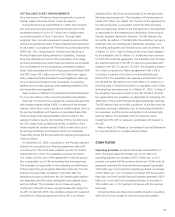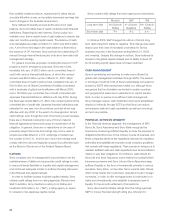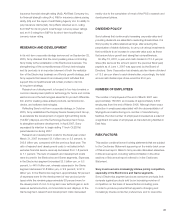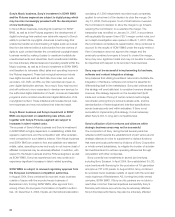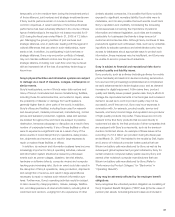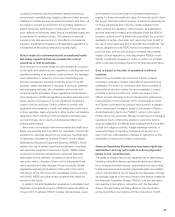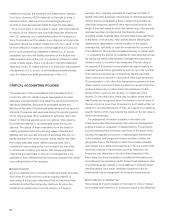Sony 2007 Annual Report Download - page 85
Download and view the complete annual report
Please find page 85 of the 2007 Sony annual report below. You can navigate through the pages in the report by either clicking on the pages listed below, or by using the keyword search tool below to find specific information within the annual report.82
the fact that a relatively high percentage of consumers already
possess products similar to those that Sony offers, Sony’s
Electronics and Game segments must develop superior technol-
ogy, anticipate consumer tastes and rapidly develop attractive
products. In the Electronics segment, Sony faces increasingly
intense pricing pressure in a variety of consumer product areas.
Sony’s sales and operating income depend on Sony’s ability to
continue to develop and offer Electronics and Game products at
competitive prices that meet changing and increasingly diverse
consumer preferences.
Sony is subject to competition from firms that may be more
specialized or have greater resources.
Sony’s businesses, primarily within the Electronics segment,
face a broad range of competitors, from large international
companies to an increasing number of relatively small, rapidly
growing, and highly specialized organizations. Sony has a
portfolio of businesses in different industries while many of its
competitors specialize in one or more of these business areas.
As a result, Sony may not fund or invest in certain of its busi-
nesses to the same degree that its competitors do, and these
competitors may have greater financial, technical, and marketing
resources available to them than the businesses of Sony against
which they compete. The Financial Services segment faces
increasing competition in Japan due to ongoing deregulation
that is eliminating barriers among the insurance, banking and
securities industries. In addition, Sony’s financial services
businesses may not be able to compete effectively, especially
against established competitors with greater financial, marketing
and other resources.
Sony may not be able to recover its increasingly diverse
and increasingly expensive investments in technology
development and production capacity.
Sony’s businesses, particularly the Electronics and Game
segments, compete in intensely competitive markets character-
ized by changing consumer preferences and rapid technological
innovation. In order to be profitable in such markets, Sony is
continuing to invest heavily in research and development and
semiconductor fabrication equipment. Recent examples of such
expenditures include research and development investment in
65 nanometer semiconductor process technology and related
capital expenditures with IBM and Toshiba for production of
the Cell/B.E. within the Electronics segment for sale primarily
to the Game segment, and an investment in a joint venture,
S-LCD, with Samsung to produce 7th generation amorphous
TFT LCD panels. In addition, by the end of the fiscal year ending
March 31, 2008, Sony Corporation and Samsung are scheduled
to complete the investment in S-LCD regarding the manufacture
of 8th generation TFT LCD panels at S-LCD. The total amount
of the investment for the 8th generation panels is expected to
be approximately 200 billion yen (approximately 50 percent of
which will be contributed by Sony Corporation). Sony may not
be able to recover these investments, in part or in full, or the
recovery of these investments may take longer than expected.
As a result, the carrying value of the related assets may be
subject to an impairment charge, which could adversely affect
Sony’s mid-term profitability. (Refer to “Trend Information.”)
Sony’s business reorganization efforts are costly and may
not attain their objectives.
Sony has engaged in significant reorganization initiatives in an
effort to allocate managerial resources into core areas and
improve operating efficiency and profitability. These efforts have
included the concentration of resources into profitable, growth
businesses by withdrawing from or downsizing selected busi-
nesses. Other efforts include the execution of a plan to reduce
costs including a reduction in the number of Sony’s employees
around the world.
On September 22, 2005, Sony announced its mid-term
corporate strategy for the three fiscal years ending March 31,
2006 through March 31, 2008. This mid-term corporate strategy
includes restructuring initiatives focused on the reduction in the
number of business categories and the number of product
models, the rationalization of manufacturing sites, the streamlin-
ing of administrative and headquarter functions, as well as the
sale of non-core assets.
In association with these restructuring initiatives, 138.7 billion
yen and 38.8 billion yen of restructuring charges were recorded
for the fiscal years ended March 31, 2006 and 2007, respectively.
Sony anticipates the recording of approximately 35 billion yen in
restructuring charges for the fiscal year ending March 31, 2008.
Restructuring charges are recorded in cost of sales, selling,
general and administrative expenses and loss on sale, disposal
or impairment of assets, net and thus decrease Sony’s consoli-
dated operating and net income. Moreover, due to internal or
external factors, the improved efficiencies and cost savings
projected may not be realized as scheduled and, even if those
benefits are realized, Sony may not be able to achieve the level
of profitability expected due to a worsening of market conditions
beyond expectations. Such possible internal factors could
include, for example, a decision to implement new restructuring
initiatives not already planned or a decision to increase research
and development outlays or other expenditures beyond currently
projected levels, either of which might increase total costs.
Possible external factors could include, for example, increased
burdens from regional labor regulations and labor union
agreements that could prevent Sony from executing its







